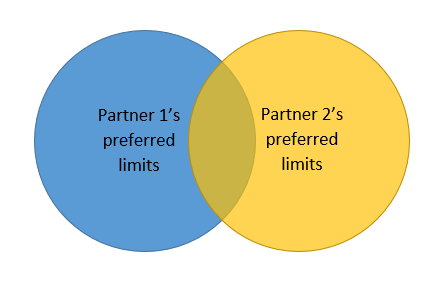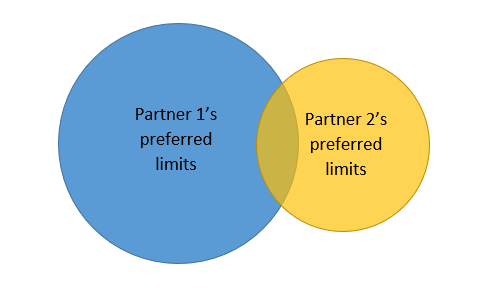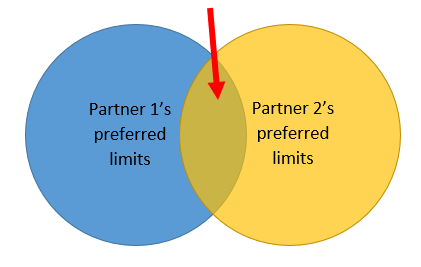I recently took a parenting class at the Parent Education Program in Kensington and during one class the teacher said “Limits worth setting are limits worth upholding.” For the last three months that statement has stuck with me because it highlights that limit setting involves a two step process – (1) making a (hopefully) thoughtful choice about what limits to set and (2) following through with the work of upholding the limit.

The Difficulty of Limit Setting
I suspect we’ve all heard our parents exclaim something like, “THAT’S IT! You’re never watching TV! For a year!” Words like this can come out of parents’ mouths during tense moments. These words highlight the problem that often we don’t know that a boundary is needed until someone has crossed it. And children seem to be incredibly creative in their boundary pushing, so it’s difficult to anticipate ahead of time what limits to set. Have no fear, I do have a few principles that can help guide you in your limit setting.
Principles of Limit Setting
- Consider your long and short term goals
You may not believe this, but one day your child will grow up. It’s helpful to think about what kind of person do you hope to raise. Most parents I speak with want their child to become a kind, competent, confident adult who is capable of handling the tasks of adulthood. Unfortunately, right now you may have a 3 year old who wants to wear their favorite PJs out on the town or a 9 year old who would rather play video games than do homework. While you may want to force your child to act in a certain way, remember that ultimately these tense moments are opportunities for them practice his or her independent thinking and problem solving skills while the stakes are low. With that in mind, you may want to loosen up and allow your child to grow. Your fifth grader may turn in their homework sporadically, but they are learning to manage their own responsibilities. Parenting with long term goals in mind means things may look a little messy right now and that’s just fine.
2. Choose a calm time to decide what limits to have
You’ll know a limit is needed when you get that deep in the gut emotional response that only your little munchkins can elicit in you. But that may not be the best time to actually set that limit. Children respond best when limits are established in a calm logical. While it’s tempting to raise your voice to get compliance, it’s not always the best way. Do whatever you need to do to calm down – lock yourself in the bathroom, do ridiculous math in your head, take 3 deep breaths, or walk away. I even heard of a parent who stowed a beach chair in the trunk of their minivan so they could pull over and sit in the chair when things heated up in the car! It may not feel fair or respectful to let the children misbehave in a tense moment, but you’re more likely to get the response you want if you take a moment to calm down before disciplining.
3. Figure out your non-negotiables
While your child may behave in lots of ways you don’t like, it’s helpful to figure out what behaviors you absolutely will not tolerate. For example, you may put with some amount of yelling when your child is angry, but put a stop when she begins hitting you or anyone else. You will not tolerate hitting, which means it’s a non-negotiable.
If you’re lucky enough to have a partner in parenting it’s important to figure out your non-negotiables together. For there to be consistent parenting across you both you’ll need to agree on what behavior your family will not tolerate. If you were to write down what behaviors your children do that annoy you and those that annoy your partner you may find this Venn diagram:
Most parents find their Venn diagram looks a little more like this:
Either way, it’s important to determine what behaviors you both agree are unacceptable. On the diagram the non-negotiables would be where the circles overlap. Those are the behaviors you are going to want to target first by healthy limit setting.
If you are parenting solo, then you’ll want to talk this out with some trusted adults or take some time to think through what behavior you will not tolerate.
4. Boil it down to the important limits
I’d recommend that you don’t try to tackle all of your child’s behaviors at first. Every year I seem to make a mile long list of New Year’s resolutions and by the end of the first week I’m burned out and back to my old habits. The same thing can happen when trying to change your child’s behavior. Burning out as a parent is more likely to happen if you’re trying to target all problematic behaviors at once. Additionally, too much new limit setting at one time can be rough on your relationship with your child.
I’d suggest picking one limit to start with (maybe two). You can either start with the behavior that that is most problematic or you can start with a small behavior that is easiest to change. Limiting the most problematic behavior may alleviate a great deal of your stress, while limiting the easiest behavior builds more momentum.
As you boil things down you may recognize that you would love to set a certain limit, but because of your family circumstances you just won’t be able to uphold it right now. That’s just fine, don’t set a limit until you’re sure you can uphold it.
Tips for Upholding Limits
There’s lots out there on upholding limits, but here are my top three tips:
- Acknowledge your child’s emotion and restate the boundary
Keep it simple. Use this two-part sentence equation: describe the emotion you see, say “and”, then state the boundary again. It may sound like, “I see that you’re angry and it’s time to get in the car.” Surprisingly, this can become a calming mantra for you as well.
2. Use language that identifies that the problem is not your child
Often when setting a limit we describe the problem as our children’s disobedience, however, it’s helpful to instead describe the problem as something external to them. For example, when a child hasn’t picked up their toys it’s tempting to say, “That’s it! YOU need to pick up your toys!” However, children tend to be more motivated to change their behavior when you calmly describe the problem as the toys on the floor. You may say, “It’s time for dinner and I still see some toys in the living room.” This small change in language helps align you with your child to solve the problem. I’ll often follow up the description with offering a choice (the next tip!).
3. Offer choices then use a statement to reinforce the child’s choice
I know, I know, offering choices is a classic tip parents of toddlers learn to master quickly, but I think it’s still worth mentioning. What I’d recommend is that after you offer a choice follow up with a statement about how it’s up to the child. These statements may be “It’s up to you.” “You’re in charge.” or “You decide.” Find one that feels less cheesy coming out of your mouth. It may sound a little like this, “You can yell all you want in your room or you can play quietly here. You decide.”
If you would like to learn more about limit setting, I’d recommend reading the book Setting Limits by Robert Mackenzie or Positive Discipline by Jane Nelsen. Additionally, I think the classes hosted by the Parent Encouragement Program here in Kensington are fantastic.


